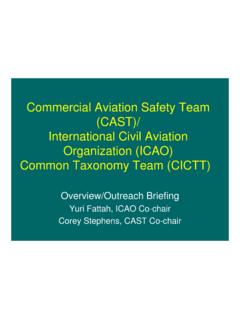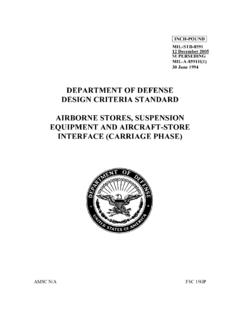Transcription of TUSKEGEE AIRMEN QUESTIONS AND ANSWERS DANIEL L. …
1 TUSKEGEE AIRMEN . QUESTIONS AND ANSWERS . DANIEL L. HAULMAN. Chief, Organizational Histories Branch Air Force Historical Research Agency Maxwell Air Force Base, Alabama 3 September 2014. 1. TUSKEGEE AIRMEN QUESTIONS AND ANSWERS . 21 August 2014 Edition DANIEL Haulman Air Force Historical Research Agency 1. Who were the TUSKEGEE AIRMEN ? The TUSKEGEE AIRMEN were the first black pilots in American military history, those who were stationed at the bases where they trained or from which they flew, those who belonged to the organizations to which the pilots belonged, or those who belonged to the support organizations for those flying units. The pilots were called TUSKEGEE AIRMEN because they trained at airfields around TUSKEGEE during World War II. The TUSKEGEE AIRMEN Incorporated uses the term DOTA (Documented Original TUSKEGEE Airman).
2 To define anyone, man or woman, military or civilian, black or white, officer or enlisted, who served at any of the air bases at which the TUSKEGEE -trained pilots trained or flew, or in any of the Army Air Force units stemming from the TUSKEGEE Experience' between the years 1941 and 1949.. 2. How did the first black pilots in the US military get started? When he was running for a third term as President, in 1940, Franklin D. Roosevelt promised to allow blacks to become military pilots. The War Department agreed to do that, but with the understanding that the black military pilots would be trained on a segregated basis, and serve in their own segregated units. 3. What was the first black flying unit in the US military? The first black flying unit in American military history was the 99th Pursuit Squadron, which was redesignated later as the 99th Fighter Squadron.
3 It was first activated at Chanute Field, Illinois, in March 1941, but it did not at first have any pilots assigned, because those pilots had not yet been trained. 4. Who was the first commander of the 99th Pursuit Squadron, which later became the 99th Fighter Squadron? The first commander of the 99th Pursuit Squadron was Captain Harold R. Maddux, a white officer. In fact, the first three commanders of the 99th Fighter Squadron were white. The first black commander of the 99th Pursuit Squadron, later the 99th Fighter Squadron, was 1st Lt. George S. Roberts, who 2. took command of the squadron on 1 June 1942. The most famous commander of the unit was Col. Benjamin O. Davis, Jr. 5. Why was TUSKEGEE chosen as the place for black military pilot training? TUSKEGEE was chosen as the place for the first black military pilot training because TUSKEGEE Institute had already been training black civilian pilots, TUSKEGEE Institute lobbied for the contract to operate a primary flight school for black pilots, the region had more days of good flying weather than many other parts of the country, and the area already had a segregated environment, which was consistent with the segregated training.
4 6. What were the phases of military flying training? Before flying aircraft, black military pilot cadets underwent pre-flight training, first at TUSKEGEE Institute, and later at TUSKEGEE Army Air Field. After pre-flight training, there were three phases of military flying training that most cadets had to complete before receiving their wings as Army Air Forces pilots: primary, basic, and advanced. The graduates then proceeded to transition training, to learn how to fly specific warplanes before entering combat. Those warplanes included fighters or bombers. Liaison and service pilots had fewer flight training phases. 7. How long were each of the three flight training phases before the black flying cadets earned their wings? During most of World War II, the primary, basic, and advanced flying training phases were generally nine weeks each, for a total of 27 weeks of flight training.
5 8. Where did the black military pilot training take place? The primary flight training phase took place at Moton Field (275 acres, 35 acres of which are now the TUSKEGEE AIRMEN National Historic Site). It had grass instead of paved runways. Cadets in the primary phase lived on the campus of TUSKEGEE Institute. The basic, advanced, and original transition flying training phases took place at a much larger airfield called TUSKEGEE Army Air Field (1,681 acres), several miles to the northwest of Moton Field, and today in ruins in the country between TUSKEGEE and Tallassee. Cadets 3. lived on the base, which had four large paved runways and three large double hangars. Additional transition training for the fighter pilots took place in the 553nd Fighter Squadron at Selfridge Field, Michigan, and later at Walterboro Army Air Field, South Carolina.
6 After their initial twin engine pilot training at TUSKEGEE , bomber pilots moved to Selfridge Field, then later at Godman Field, Kentucky, then still later at Freeman Field, Indiana, in the 477th Bombardment Group. 9. Were all of the black flying cadets college-educated? The first black flying cadets were college-educated, but as the war went on, high school graduates without college credit were accepted into the program. To help provide some college-level training to those cadets, the 320th College Training Detachment was activated at TUSKEGEE Institute on 25. April 1943. After five months, graduates of that program were ready to become aviation cadets, and transferred to TUSKEGEE Army Air Field for pre- flight training. were some of the leaders of black pilot training at TUSKEGEE ?
7 There were many black and white flight instructors who trained the first black pilots in American military history. Most flight instructors in primary flight training at Moton Field were black, and at first flight instructors in basic and advanced flight training at TUSKEGEE Army Air Field were all white. Eventually, black flight instructors also served at TUSKEGEE Army Air Field, but they were never the majority of the flight instructors there. One of the most important black flight instructors at Moton Field was Charles Alfred Anderson, whom the students called Chief because he had been the chief civilian pilot instructor at Kennedy Field before that. Chief Anderson served under Lewis A. Jackson, who headed TUSKEGEE Institute's Division of Aeronautics, and George L.
8 Washington, the General Manager of Moton Field. Washington, Jackson, and Anderson were all black, but the field also had some white military officers. One of the most important of the many white flight instructors at TUSKEGEE Army Air Field, who taught advanced flying training to single engine pilots, was Major Robert Long. The cadets affectionately called him Mother Long. The commander of the flight training school at TUSKEGEE Army Air Field was Col. Noel F. Parrish, a white officer from the South. The cadets generally remembered Parrish as a fair man who was generally interested in their success. 4. did the first black military pilots in the armed forces graduate? Although 13 black cadets started in the first class of flying training at TUSKEGEE , in 1941, only five of them graduated, in March of 1942.
9 One of the five was Benjamin O. Davis, Jr., a West Point graduate whose father was the first black general in the Army. Davis himself would eventually become the first black general in the Air Force. 12. How long was the 99th Fighter Squadron active before it received its first pilots? The 99th Fighter Squadron was active for about a year before it had any pilots. It had been activated in March 1941, and received its first pilots in March 1942. 13. What kinds of airplanes did the TUSKEGEE AIRMEN fly in training? In primary flying training, the TUSKEGEE AIRMEN flew PT-17 and PT-13. biplanes, and occasionally P-19 monoplanes, on a grass strip at Moton Field. In basic flying training at TUSKEGEE Army Air Field, they flew BT-13. airplanes, and later AT-6s.
10 In advanced flying training, also at TUSKEGEE Army Air Field, future fighter pilots flew AT-6 airplanes, and future bomber pilots flew twin-engine AT-10 airplanes. Later, the AT-10 planes were replaced by TB-25s. For transition training the future fighter pilots flew P- 40s and the future bomber pilots flew B-25s. Fighter pilots also flew P-39s and P-47s in transition training beyond TUSKEGEE . 14. How many classes of pilots graduated from advanced pilot training at TUSKEGEE Army Air Field? There were 44 classes of pilots who graduated from advanced flying training at TUSKEGEE Army Air Field. 15. How many black TUSKEGEE AIRMEN pilots were there in all? There were 930 pilots who graduated from advanced flying training at TUSKEGEE Army Air Field. In addition to that, there were 51 liaison pilots who trained there, and 11 service pilots, for a total of 992 black pilots 5.





